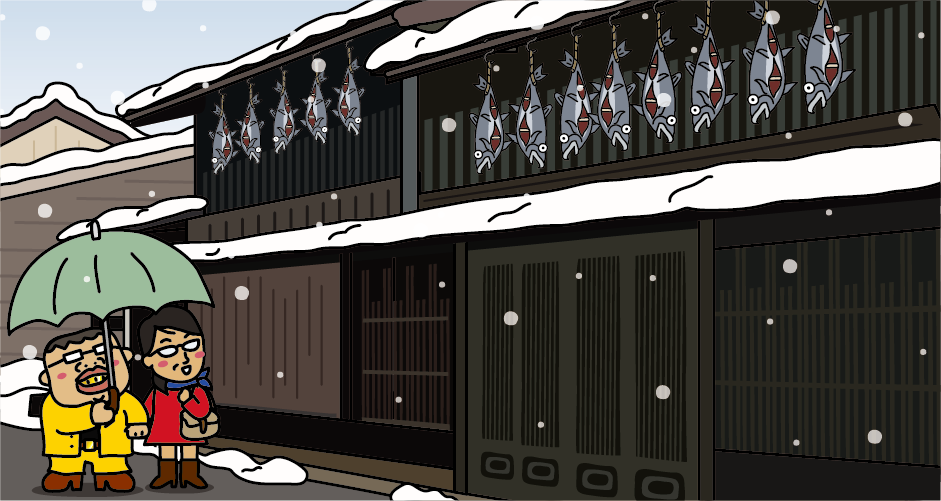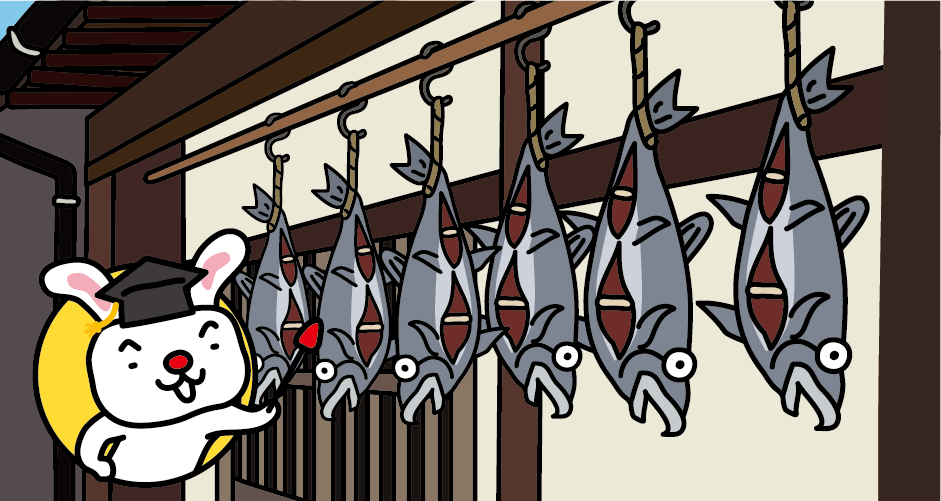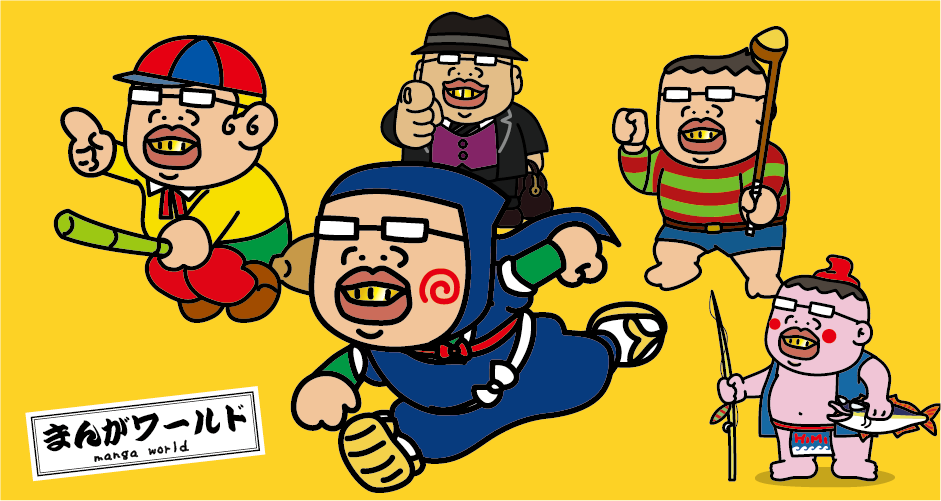Tourist spots in Murakami City, Niigata Prefecture related to salmon called Iyoboya
People on Murakami City, Niigata love salmon very much. They eat everything from head to tail of salmon, so cats in Murakami City surely feel bitter because they cannot have a tiny share of it. I just cannot help feeling sorry to them.
In Murakami district of Niigata Prefecture, salmon is called as “Iyoboya” for a long time. In Murakami, both “Iyo” and “Boya” are words expressing fish, so Iyoboya means “fish of fish”. Miomote River flowing to Murakami was known as a salmon river since the Heian era, and its salmon was dedicated to the Imperial Court as a tax. In the Edo era, salmon became an important source of income to support the finance of the domain of Murakami.

In winter, there is a unique culture of hanging salmon at the space under the eaves to make “Shiobiki Sake (salted salmon)” and this is a Murakami’s winter tradition. The scenery that salted salmon are hung under the eaves of each house is called “Sake Shiobiki Kaidou (salted salmon street)”.

Shiobiki Sake is a processed food of salmon which removed salmon’s internal organs, rubbed salt, aged by exposing it to cold wind blown from the Sea of Japan. Its processing method is also unique; when they cut salmon, they do not cut all the belly and leave some parts, and they hang the salmon head downward. The reason for hanging the salmon head down is for not imagining the “hanging”. And reason for keeping the part of stomach attached is try not to imagine “hara-kiri”. This is a traditional custom of the castle town, Murakami.

Thanks to the Tane River, Murakami salmon became famous nationwide. In the latter half of the Edo era, because of overfishing, salmon in Miomote River became poor year by year. The samurai of the domain of Murakami,Bu heiji Aoto, who was studying the ecology of salmon, discovered salmon’s “mother-river homing” and succeeded in artificial breeding of salmon for the first time in the world. His method was to create “Tane River” which is a branch flow of Miomote River, set fences to enclose salmon, prevent salmon from running upwards and make salmon lay eggs at “Tane River”. As a result, the catches of salmon increased dramatically, and the domain of Murakami had profited pretty much.

The “mother-river homing (Salmon run)” means returning to the river where the salmon were born. Salmon fry spawn in rivers descend into the sea in spring, spending time in summer and autumn in the Sea of Okhotsk. Then, they migrate to the western part of the North Pacific Ocean to survive the winter. In the summer of next year, they migrate up to the Bering Sea and grow large by consuming their prey. Then, in autumn, they move south to the Gulf of Alaska and survive the winter. After that, juvenile salmon go back and forth between the Bering Sea in summer and the Gulf of Alaska in winter. Four years later, the adult salmon move south along the Kuril Islands from the Bering Sea and return to the river in Japan where they were born in autumn.

Buheiji Aoto was also known as an engineer in the civil engineering fields, such as fields area measurement and river construction, but because 30 years were spent on the construction of Tane River, Buheiji Aoto never saw the completed Tane River. The “Tanegawa-no-Sei (Tane River System)” established by Buheiji Aoto enabled the world’s first natural incubation and propagation of salmon. His achievements are extremely great. In Salmon Park, where the “Iyoboya Hall” is located, there is a bronze statue of “Buheiji Aoto.”

“Iyoboya Hall” is the first salmon museum in Japan located along the Miomote River. At there, you can study the history, culture, etc. of salmon in Miomote River.

The highlight of Iyoboya Hall is “Ecology Observation Room” and “Salmon Observation Nature Hall” located in the basement. At “Ecology Observation Room”, you can observe the ecology of salmon from fry to adult fish. At “Salmon Observation Nature Hall” of 50 meters in length, you can observe creatures inhabiting Tane River through the glass because there are 10 observation windows have set in Tane River. In autumn, you can observe the group of salmon that goes up the river and if you are lucky, you can observe salmon laying eggs.

“Iguriami Ryo (fishing by reeling net)” is a traditional fishing method of Miomote River handed down from Edo era. Its fishing method is that three small boats became a group, one boat hit surface of the water with stick and chase salmon into a net stretched between other two boats. You can visit the river side of Miomote River near Iyoboya Hall and see this fishing method from the middle of October to middle of December every year.
Access to Iyoboya Hall
From Tokyo
It takes about 2 hours from JR Tokyo Station to JR Niigata Station by Joetsu Shinkansen.
From Osaka
It takes about 1 hour from Itami Airport to Niigata Airport. It takes about 25 minutes from Niigata Airport to JR Niigata Station by shuttle bus.
Transfer to the JR Hakushin Line at JR Niigata Station, and it takes about 40 minutes from JR Niigata Station to JR Shibata Station. Transfer to the JR Uetsu Main Line at JR Shibata Station, and it takes about 40 minutes from JR Shibata Station to JR Murakami Station. Get off at JR Murakami Station and walk for about 20 minutes to Iyoboya Hall. Alternatively, it takes about 5 minutes from Murakami-ekimae bus stop to Kosuke-jima bus stop. It is about 5 minute-walk from Kosuke-jima bus stop to Iyoboya Hall.










You need to login to comment on an article.